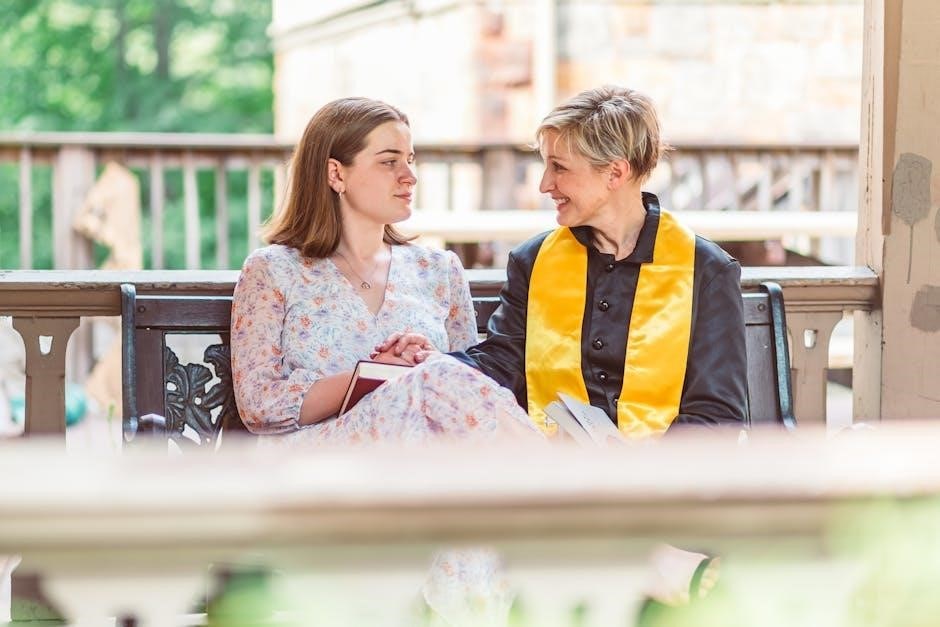Title: The Blackman’s Guide to Understanding the Blackwoman
This controversial book by Shahrazad Ali explores dynamics in Black relationships, offering insights into cultural challenges, gender roles, and communication strategies․ Available in PDF format for educational purposes, it sparks debates while fostering dialogue on mutual respect and understanding in the Black community․
1․1․ Overview of the Book
The Blackman’s Guide to Understanding the Blackwoman by Shahrazad Ali is a controversial yet insightful exploration of Black male-female relationships․ Published in 1989, the book delves into historical context, cultural nuances, and gender dynamics, offering strategies for fostering empathy and mutual respect․ Available in PDF format, it remains a significant work for understanding Black relationships, sparking dialogue on communication, respect, and cultural challenges within the Black community․
1․2․ Author Background: Shahrazad Ali
Shahrazad Ali is a notable author known for her provocative works on Black relationships․ Born in 1947, she gained recognition with The Blackman’s Guide to Understanding the Blackwoman in 1989․ Her writing often addresses cultural challenges and gender dynamics within the Black community, aiming to foster mutual understanding and respect․ Ali’s work has sparked both acclaim and controversy, making her a significant voice in discussions on race and gender․

Historical Context of Black Relationships
Historical context reveals systemic oppression and resilience shaping Black relationships, influenced by slavery, segregation, and societal expectations, fostering unique cultural dynamics and community bonds․
2․1․ Impact of Slavery and Segregation
Slavery and segregation severely disrupted Black relationships by separating families and imposing oppressive systems․ These injustices caused deep emotional trauma, fostering mistrust and communication challenges․ The legacy of systemic racism continues to influence dynamics, as historical wounds impact intimacy and collaboration, requiring conscious effort to heal and rebuild connections․
2․2․ Evolution of Gender Roles in the Black Community
Historically, Black gender roles were shaped by slavery, systemic oppression, and societal expectations․ Traditional roles often emphasized male provider status and female nurturing, but these norms have evolved․ The civil rights movement and modern feminism have influenced more equitable partnerships․ Understanding this evolution is crucial for fostering mutual respect and collaboration in contemporary Black relationships․

Understanding the Black Woman’s Experience
Black women’s experiences are shaped by cultural identity, societal expectations, and historical resilience․ Their unique perspectives blend strength, heritage, and challenges, fostering deeper connections and empathy․
3․1․ Cultural Nuances and Identity
Black women’s cultural identity is deeply rooted in heritage, traditions, and societal perceptions․ Their experiences are shaped by intersecting factors like race, gender, and class, influencing self-perception and societal roles․ Understanding these nuances requires acknowledging historical resilience and the blending of African and Western cultural influences, which define their unique identity and worldview in both individual and collective contexts․
3․2․ Portrayal of Black Women in Society
Black women are often subjected to stereotypical portrayals in media and society, historically depicted as the “mammie” or “jezebel․” These narratives perpetuate harmful misconceptions, reducing their complexity to oversimplified roles․ Modern society still grapples with these biases, often overlooking their multidimensional identities and contributions․ Addressing these portrayals is crucial for fostering accurate understanding and appreciation of Black women’s diverse experiences and strengths․

Communication Strategies
Effective communication is vital, emphasizing active listening, empathy, and clarity to foster mutual understanding and respect, thereby strengthening the foundation of relationships․
4․1․ Effective Dialogue in Relationships
Effective dialogue fosters trust, intimacy, and mutual respect․ Active listening, clarity in expression, and empathy are key․ Encouraging open conversations helps address emotions and concerns, ensuring both partners feel heard․ Avoid assumptions and validate each other’s experiences, creating a safe space for honest exchange․ Non-verbal cues and patience further enhance communication, strengthening the bond and understanding between partners․
4․2․ Overcoming Misunderstandings
Overcoming misunderstandings requires patience, empathy, and a willingness to address triggers․ Active listening and clarifying assumptions can prevent escalations․ Acknowledging each other’s perspectives fosters mutual understanding․ Validating feelings, even when disagreeing, builds trust․ Addressing conflicts calmly and seeking solutions together strengthens the relationship․ Openness and commitment to growth help navigate challenges, ensuring misunderstandings lead to deeper connection rather than division․
Gender Roles and Expectations
Gender roles and expectations in Black relationships are shaped by cultural heritage, societal norms, and historical contexts․ Understanding these dynamics fosters mutual respect and balanced partnerships․
5․1․ Traditional vs․ Modern Perspectives
Traditional perspectives often emphasize distinct gender roles, with men as providers and women as nurturers, rooted in cultural and historical norms․ Modern views advocate for equality, shared responsibilities, and mutual respect, reflecting evolving societal dynamics․ Understanding these shifts helps bridge generational gaps and fosters healthier relationships, respecting both heritage and contemporary values․
5․2․ The Role of Respect in Relationships
Respect is a cornerstone of healthy relationships, fostering trust and understanding․ It involves acknowledging each other’s feelings, boundaries, and contributions․ Mutual respect bridges gaps, validating individuality while strengthening bonds․ In the context of cultural and personal identity, respect is essential for harmony and progress, ensuring both partners feel valued and heard․

Cultural Challenges and Stereotypes
Cultural challenges and stereotypes impact Black relationships, influenced by systemic racism and societal portrayals․ These factors create misunderstandings, reinforcing harmful narratives and affecting trust and communication․
6․1․ Impact of Systemic Racism
Systemic racism deeply affects Black relationships, rooted in historical oppression and ongoing disparities․ Slavery and segregation disrupted family structures, fostering power imbalances and toxic gender roles․ Economic inequality and limited opportunities further strain relationships, perpetuating cycles of mistrust and frustration․ These systemic issues infiltrate daily interactions, complicating communication and intimacy between Black men and women․
6․2․ Breaking Down Stereotypes
Breaking down stereotypes requires challenging societal myths about Black women, such as the “angry Black woman” trope or the hypersexualized narrative․ Education, open dialogue, and media representation play crucial roles in dispelling these harmful notions․ By fostering mutual understanding and empathy, Black men and women can dismantle stereotypes rooted in systemic racism and cultural biases, promoting healthier, more authentic relationships․

Psychological and Emotional Aspects
Exploring the emotional and psychological dynamics between Black men and women is crucial for understanding their relationships․ Historical trauma, communication styles, and mutual support are key factors․
7․1․ Emotional Landscapes of Black Women
Black women’s emotional landscapes are shaped by resilience, cultural identity, and societal expectations․ Historical oppression, gender roles, and community dynamics influence their emotional well-being․ Understanding these factors is vital for fostering empathy and connection in relationships․
7․2․ Mental Health in Relationships
Mental health plays a crucial role in relationships, often influenced by unresolved stress, trauma, or anxiety․ Open communication helps address these challenges, fostering trust and intimacy․ Societal pressures and stereotypes can exacerbate mental health struggles, leading to misunderstandings․ Encouraging mutual support and understanding is essential for creating a nurturing environment that prioritizes emotional well-being, ultimately strengthening the bond between partners․

Strategies for Building Stronger Relationships
Effective communication, mutual respect, and empathy are key to fostering strong relationships․ Trust-building, active listening, and understanding each other’s perspectives help create a foundation for lasting connections and harmony․
8․1; Mutual Understanding and Empathy
Mutual understanding and empathy are vital for bridging gaps in relationships․ By actively listening and acknowledging each other’s experiences, Black men and women can foster deeper connections; Empathy helps dissolve misunderstandings, creating a safe space for open dialogue․ Understanding each other’s perspectives strengthens trust and respect, laying the foundation for harmonious and fulfilling partnerships․
8․2․ Fostering Healthy Connections
Fostering healthy connections requires trust, respect, and consistent effort․ Open communication and shared goals strengthen bonds, while mutual accountability ensures growth․ Celebrating each other’s strengths and supporting weaknesses create a balanced partnership․ Healthy connections thrive when both parties prioritize emotional well-being and work collaboratively to overcome challenges, building a resilient and nurturing relationship dynamic․

Controversies Surrounding the Book
The book sparked intense debates due to its controversial views on gender roles and relationships․ Critics accused Shahrazad Ali of promoting divisive stereotypes, while others defended its raw honesty․
9․1․ Criticisms and Debates
The book faced backlash for its perceived misogynistic tone and controversial advice․ Critics argued that it reinforced harmful stereotypes about Black women and placed undue blame on them for relationship issues․ Some labeled it divisive, while others defended it as a necessary, albeit harsh, perspective․ The debates highlighted deep divides in how Black relationships and gender roles are perceived within the community․
9․2․ The Book’s Impact on the Community
The book sparked intense discussions within the Black community, with some hailing it as a bold wake-up call for introspection․ Others criticized its divisive rhetoric, arguing it widened relational gaps․ Despite the controversy, it remains a significant text in exploring gender dynamics and cultural challenges, prompting conversations that continue to resonate in both personal and public spheres․

Reception and Reviews
The book received mixed reviews, with some praising its raw honesty and others criticizing its controversial approach․ It sparked debates, dividing opinions on its cultural impact․
10․1․ Positive Feedback and Support
Many readers praised the book for its bold approach to addressing relationship dynamics․ It was seen as a catalyst for open dialogue and empowerment within the Black community․ Supporters appreciated its raw honesty and the way it challenged traditional norms; The book resonated with those seeking deeper cultural understanding and connection, fostering a sense of unity and shared purpose among its audience․
10․2․ Negative Reactions and Criticism
The book faced criticism for its controversial views on gender roles and relationships․ Some labeled it misogynistic and divisive, arguing it perpetuated harmful stereotypes․ Critics felt it overlooked systemic issues and didn’t adequately address the broader challenges faced by Black women․ Despite this, the debate it sparked highlighted the complexity of Black relationships and the need for ongoing dialogue․
The Blackwoman’s Guide to Understanding the Blackman
Shahrazad Ali’s companion book offers a balanced perspective, fostering mutual understanding between Black men and women․ It complements the original guide, encouraging dialogue and harmony․
11․1․ Companion Book by Shahrazad Ali
Shahrazad Ali’s The Blackwoman’s Guide to Understanding the Blackman serves as a companion to her earlier work․ It explores themes of mutual respect, communication, and cultural understanding․ The book addresses gender roles, societal expectations, and emotional connections, offering insights into fostering healthier relationships․ Ali’s work aims to bridge gaps between Black men and women, promoting unity and empathy within the community․
11․2․ Comparative Analysis
Shahrazad Ali’s The Blackwoman’s Guide to Understanding the Blackman and The Blackman’s Guide to Understanding the Blackwoman offer complementary perspectives․ Both books address gender dynamics, cultural challenges, and relationship-building within the Black community․ While they cover similar themes, each provides unique insights, fostering a balanced understanding․ Together, they encourage mutual respect, empathy, and unity, making them invaluable resources for personal and collective growth․
Digital Availability and Access
The Blackman’s Guide to Understanding the Blackwoman is widely available in PDF and ebook formats on platforms like Amazon, Google Play, and eBay․ Popular websites offer free downloads, though unauthorized distribution remains a concern․
12․1․ PDF Format and Ebook Readers
The Blackman’s Guide to Understanding the Blackwoman is accessible in PDF format, compatible with ebook readers like Kindle, Nook, and Kobo․ It can be downloaded from platforms such as Amazon, Barnes & Noble, and Kobo Books․ The PDF version ensures easy access across devices, making it convenient for readers to engage with the content on-the-go while maintaining the book’s original formatting and structure․
12․2․ Free Downloads and Resources
The Blackman’s Guide to Understanding the Blackwoman is widely available as a free PDF download through various online platforms․ Many websites offer the book for free, making it accessible to a broader audience․ However, readers are encouraged to support the author by purchasing the book from authorized sources․ Free resources often include excerpts or summaries, but the full PDF provides comprehensive insights into the topic․

Educational and Cultural Significance
The book serves as a vital educational tool, fostering dialogue and understanding within the Black community․ Its cultural significance lies in addressing gender dynamics and societal impacts․
13․1․ Use in Academic Settings
The book is often incorporated into university curricula, particularly in sociology, African American studies, and gender studies courses․ It sparks critical discussions on race, gender, and relationships, encouraging students to explore historical and cultural contexts․ Professors use it to examine gender dynamics within the Black community, fostering deeper understanding and debate among scholars․
13․2․ Contribution to Intercultural Understanding
The book bridges cultural gaps by addressing unique challenges faced by Black men and women, fostering mutual respect and understanding․ It encourages dialogue across racial and gender lines, providing insights into the historical and social contexts shaping Black relationships․ This fosters empathy and collaboration, helping to break down stereotypes and promote harmony within and beyond the Black community․
Personal Growth and Development
The book fosters self-awareness, emotional intelligence, and introspection, helping Black men and women grow individually and relationally by embracing mutual respect and understanding․
14․1․ Lessons for Black Men and Women
The book offers profound insights, encouraging Black men and women to embrace mutual respect, communication, and understanding․ It highlights the importance of addressing emotional and psychological barriers while fostering healthier relationships․ By promoting self-reflection and cultural awareness, the guide equips both genders with tools to navigate challenges and build stronger, more meaningful connections rooted in empathy and shared growth․
14․2․ Applying the Book’s Insights
Applying the book’s insights involves integrating its lessons into daily interactions, fostering open communication, and addressing conflicts with empathy․ Readers are encouraged to challenge stereotypes and embrace cultural understanding․ By prioritizing mutual respect and emotional intelligence, individuals can build stronger, more harmonious relationships․ The guide’s practical advice empowers both partners to grow together, creating a foundation for lasting, meaningful connections․
This guide bridges gaps, fostering mutual respect and understanding between Black men and women․ Its insights encourage empathy and collective growth, inspiring healthier relationships․
15․1․ Summary of Key Points
The book serves as a vital resource for understanding Black women’s experiences, offering insights into historical context, communication, and gender roles․ It addresses cultural challenges and stereotypes while providing practical advice for fostering healthier relationships․ By emphasizing mutual respect and empathy, it aims to bridge gaps and strengthen bonds within the Black community, encouraging personal growth and unity․
15․2․ Encouragement for Further Reading
Readers are encouraged to explore additional literature on Black relationships and cultural dynamics․ Supplementary books and discussions can deepen understanding and foster growth․ Engaging with diverse perspectives enriches insights, while community dialogues provide shared learning opportunities․ Embrace lifelong education to strengthen connections and promote unity within the Black community․




